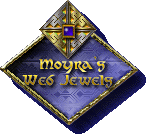The Camelot Legend

 Arthur's Family History
Arthur's Family History
Uther Pendragon was originally the King of England and Arthur's father. He fell in love with Igrainne of Cornwall, and formulated a wild plot to take her from her husband Gorlois, Duke of Cornwall. Uther succeeded, with the help of Merlin, killing Gorlois in the process. (Merlin extracted from Uther a promise that the offspring from Uther's first night with Igrainne be forfeited to Merlin, and he be allowed to raise the child as he saw fit... but, *sigh* that's a whole other chapter!)
Uther then married Igrainne and caused her to become pregnant, she later gave birth to Arthur (who was given over to Merlin). Now, Igrainne already had two daughters by Gorlois... Morganna (also referred to as Morgan le Fay), and Morgause. These are Arthur's half-sisters. Arthur's incestuous affair was with Morgause, NOT Morganna! This affair occured BEFORE Arthur fell in love with Guinevere, and Arthur did not, at the time of the affair, know that Morgause was his half-sister.
Therefore, Mordred is Morgause's son. He is Morganna's nephew. Morgause was apparently very quiet about the whole thing, and remained loyal to Arthur. She was not a very strong-willed mother to Mordred. Morganna, on the other hand, was assertive and vindictive. She was forceful and downright mean to Morgause, and had more to do with Mordred's upbringing than anyone. She felt slighted in that she believed that since she was step-daughter to Uther, she should have certain royal rights, which she did not receive. She was pretty much ostracized by the royal family, especially Guinevere later on, and swore herself an enemy of Arthur and all he stood for.
 Historical Information and References
Historical Information and References
The following is excerpted from The Chronicles of King Arthur by Andrea Hopkins. (Comments in [[brackets]] are by our RP King Arthur, Artorious Roithamus)
St Gildas seems to have written his book in about 545 AD. In common with other historians, he reports that a British high king had invited a large number of Saxon mercenaries to settle in Britain in order to support him against internal strife, and that these troops subsequently mutinied and overran the lands of their former overlords. This king is clearly the character whom later historians call Vortigern.
Two historical mentions of Arthur occur in the "Annals of Wales", an anonymous Latin chronicle compiled between about 960 AD and 980 AD, from a number of older sources. Some of the material in this history is certainly very old. The years are numbered 1 to 533; though the year 1 is probably actually 445 AD. The entries relating to Arthur are:
"Year 72: The Battle of Badon in which Arthur bore the cross of Our Lord Jesus Christ on his shoulders for three days and nights, and the Britons were the victors."
"Year 93: The strife (battle) of Camlann in which Arthur and Medraut (Mordred) perished; and there was plague in Britain and Ireland."
[[In many accounts, Camlann was the site of Arthur's final battle. Camlann still exists, in Wales.]]
A small amount of archaeological evidence supports the story told so sparingly in the histories. There are signs that after the first raids and revolts by the Saxons, a British resistance did arise under organized leadership. Excavations in the 1960's and 1970's at Cadbury, originally an Iron Age hill fort, showed that it had been substantially refortified in the Fifth Century, and that it had enclosed and supported a court of quite impressive size. It has been concluded that this may very well have been CAMELOT.
Reasonably reliable records have survived which tell of a British king who led an army into Gaul on behalf of the fragmenting Roman Empire to combat the invading forces of the Visigothic King Euric in 468 AD. This king is known in the sources as Roithamus, a latinization of the British word Rigotamos, meaning "high king". This is clearly his title rather than his name, and the records speculate that his personal name might have been Arthur. Arthur is itself a British version of the roman name Artorius, which is also prevalent in these records. Roithamus advanced with his army into Burgundy; he was subsequently betrayed by a deputy who made a pact with the Visigoths and, after a disastrous battle (in CAMLANN) in which most of his army was killed, Artorius Roithamus escaped with a few trusted men and disappeared from the records. Interestingly, the direction in which he was going when he escaped was towards a small town in Burgundy called Avallon. This took place between 468 AD and 470 AD.
[[This means that it is quite possible that Arthur ESCAPED AND LIVED!! The legends written regarding his death were merely fabricated as a means of explaining his disappearance!! Remember the usual military war-time label: "Missing-In-Action, Presumed Dead"?]]
Roithamus could have been the king who united the British against the Saxons and refortified various strongholds in the west, before crossing to Gaul and fighting against the Visigoths for Rome.
[[Lyonnesse (Leonesse) was located in western England, now Wales. This is a fact.]]
Most fascinating and mysterious of all is the Arthurian relief carved into the archivolt over the north door of the Modena Cathedral in Italy. The carving shows a moated castle in which a lady is being held prisoner by a man. All the characters are identified by names carved above them; these two are "Winlogee" (Guinevere?) and "Mardoc" (Malagant?). To the left of the castle a man called "Burmaltus", who is armed with an axe or hammer, defends Mardoc and the castle against three mounted knights, two of whom are named as "Isdernus" and "Artus de Bretania". To the right of the castle, a knight named "Carrado" is riding out of the gate to attack another knight, "Galvagin" (Gawain?). The carving is early Twelfth Century, probably between 1120 and 1140, and clearly contains characters and an incident which must have been based on an Arthurian source.
By the final quarter of the Twelfth Century, the new literary mode in France had found a master who could never be surpassed; Chretien de Troyes. Two of his five surviving poems, "Lancelot" and "Perceval", were possibly the most influential romances written in the Middle Ages. "Lancelot" introduced the character of Sir Lancelot and the subject of his long love affair with Queen Guinevere; subsequently his story became absolutely central to the Arthurian cycle. "Perceval" was the first surviving written version of the Grail legend and, though Chretien did not live long enough to finish it, the fragment that he wrote was continued by four other poets and inspired all subsequent versions including the "Queste del Saint Graal", the work of a group of brilliant German poets, most of whom were "ministeriales" (unfree knights bound to the service of their lords). These ministeriales translated Chretien's work into German.
[[Keep in mind that in the Middle Ages, a "poet" was not necessarily a writer of fiction, but rather one who accounted history in a poetic medium.]]
In England, as might be expected, Arthurian romance was very popular. Over half the surviving English romances are about individual knights and their adventures. Of these, the most popular hero by far is Sir Gawain. By contrast, Sir Lancelot, the supreme hero of French romance, features in only one surviving poem, the Scottish "Lancelot of the Laik". Not until Sir Thomas Malory, himself a knight under King Edward during the 1450's-1460's, did anyone attempt to compile their own coherent cycle of Arthurian events. Malory's version was widely accepted in that it cut out a great deal of long rambling material from French sources and incorporated new material from English sources. This combination made the history more of a romantic story, easier to follow, and thus more popular. It seems likely that this work was done over a period of years, and in separate books. Malory's version also included his later work, "Morte D'Arthur", which offered an account of Arthur's death; this was accepted because it gave a conclusiveness to the tale, a dramatic ending which was popular in English romances of the time.
 Listing of the Knights of the Round Table
Listing of the Knights of the Round Table
- Sir Agravain (younger brother to Sir Gawain)
- Sir Balan
- Sir Balin le Savage (also known as "The Knight with the Two Swords")
- Sir Bedivere (survivor of Battle of Camlann)
- Sir Bors
- Sir Gaheris
- Sir Galahad (The "Grail Knight". Son of Sir Lancelot by Elaine of Corbenic. Proven the best knight in the world by achieving the Quest of the Holy Grail most perfectly.)
- Sir Gareth
- Sir Gawain (Son of Morgause, half-brother to Mordred.)
- Sir Kay (foster brother and seneschal of Arthur.)
- Sir Lancelot (SECOND as best knight, Galahad was First.)
- Sir Mordred (Illegitimate son of Arthur's incestuous relationship with his half-sister Morgause. Started as knight of the round, banished after attempting to usurp the throne.)
- Sir (King) Pellinore (Ally of Arthur, father of Sir Perceval.)
- Sir Perceval
- Sir Tor
- Sir Tristan

Return to
Writings

Return to
Camelot main page
Graphics from Moyra's Web Jewels.
Visit her site, it's amazing!